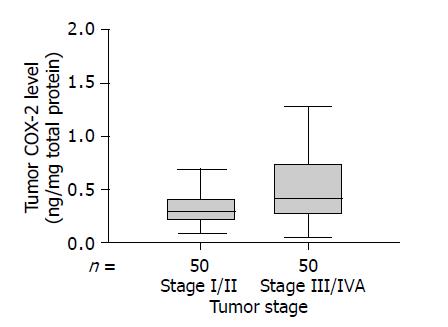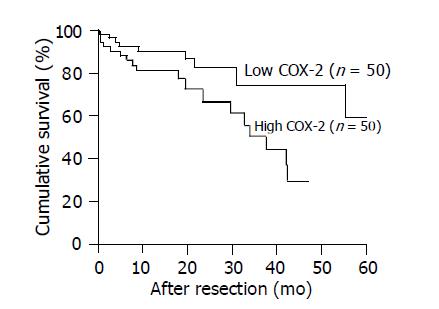Copyright
©2005 Baishideng Publishing Group Inc.
World J Gastroenterol. Apr 7, 2005; 11(13): 1896-1902
Published online Apr 7, 2005. doi: 10.3748/wjg.v11.i13.1896
Published online Apr 7, 2005. doi: 10.3748/wjg.v11.i13.1896
Figure 1 Immunohistochemical staining for COX-2.
A: a section of a HCC showing expression of the COX-2 protein (brownish staining) predominantly in the tumor cells; B: a section of nontumorous liver tissue showing expression of the COX-2 protein in the hepatocytes (magnification 10×).
Figure 2 Boxplots showing significantly higher tumor COX-2 levels in patients with advanced tumor stage (III and IVA) compared with those with early tumor stage (I or II) (P = 0.
008). The upper and lower horizontal lines of the box indicate the 25th and 75th percentiles, respectively. The lines within the box indicate the median values. The upper and lower horizontal bars indicate data within 1.5 times the interquartile range.
Figure 3 Cumulative survival curves of patients with high tumor cytosolic COX-2 (>0.
350 ng/mg total protein) and low tumor cytosolic COX-2 (<0.350 ng/mg total protein) levels (P = 0.027).
- Citation: Tang TC, Poon RT, Lau CP, Xie D, Fan ST. Tumor cyclooxygenase-2 levels correlate with tumor invasiveness in human hepatocellular carcinoma. World J Gastroenterol 2005; 11(13): 1896-1902
- URL: https://www.wjgnet.com/1007-9327/full/v11/i13/1896.htm
- DOI: https://dx.doi.org/10.3748/wjg.v11.i13.1896











